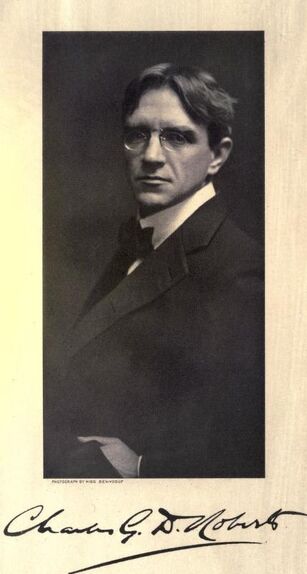
Charles G.D. Roberts (1860-1943), from Poems, 1901. Photo by Zaida Ben-Yusuf (1869-1933). Courtesy Internet Archive.
| Sir Charles G.D. Roberts | |
|---|---|
| Born |
Charles George Douglas Roberts January 10, 1860 Douglas, New Brunswick |
| Died | November 26, 1943 |
| Education | M.A. |
| Alma mater | University of New Brunswick |
| Literary movement | Confederation Poets, The Song Fishermen |
| Notable work(s) |
Songs of the Common Day, The Iceberg, and other poems |
| Notable award(s) | Knighthood (KCMG), FRSC |
| Spouse(s) | Mary Fenety, Joan Montgomery |
| Children | 5 (including Lloyd Roberts) |
Sir Charles George Douglas Roberts KCMG FRSC (January 10, 1860 - November 26, 1943) was a Canadian poet and prose writer, who is known as the Father of Canadian Poetry.[1]
Life[]
Overview[]
Roberts was "almost the first Canadian author to obtain worldwide reputation and influence; he was also a tireless promoter and encourager of Canadian literature.... He published numerous works on Canadian exploration and natural history, verse, travel books, and fiction."[2] "At his death he was regarded as Canada's leading man of letters."[3]
Roberts has often been called the 'Father of Canadian Literature,' "not just for his remarkable output, but also for his commitment to fostering a national literature and his generous encouragement of young Canadian writers."[4]
Roberts, his cousin Bliss Carman, Archibald Lampman, and Duncan Campbell Scott are known as the Confederation Poets.[5]
Youth and education[]
Roberts was born in Douglas, New Brunswick in 1860, the eldest child of Emma Wetmore Bliss and Rev. George Goodridge Roberts (an Anglican priest). His brothers Theodore Goodridge Roberts and William Carman Roberts, and sister, Jane Elizabeth MacDonald, would also become poets.
Between the ages of 8 months and 14 years, Roberts grew up in the parish of Westcock, near Sackville, New Brunswick, by the Tantramar Marshes. He was homeschooled, "mostly by his father, who was proficient in Greek, Latin and French." He published his 1st writing, 3 articles in The Colonial Farmer, at 12 years of age.[6]
After the family moved to Fredericton, New Brunswick, in 1873,[6] Roberts attended Fredericton Collegiate School from 1874 to 1876, and then the University of New Brunswick (UNB), earning his B.A. in 1879 and M.A. in 1881.[7] At the Collegiate School he came under the influence of headmaster George Robert Parkin, who gave him a love of classical literature [6] and introduced him to the poetry of Dante Gabriel Rossetti and Algernon Charles Swinburne.[8]
Early Canadian career[]
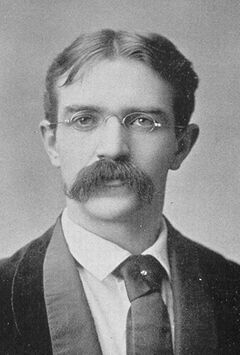
Roberts in 1893. Courtesy The Yellow Nineties Online.
Roberts was principal of Chatham High School in Chatham, New Brunswick, from 1879 to 1881, and of York Street School in Fredericton from 1881 to 1883.[6] In Chatham he met and befriended Edmund Collins, editor of the Chatham Star and the future biographer of Sir John A. Macdonald.[8]
Roberts 1st published poetry in the Canadian Illustrated News of March 30, 1878, and by 1879 he had placed 2 poems in the prestigious American literary magazine, Scribner's Monthly.[8]
In 1880 Roberts published his first book of poetry, Orion, and other poems.[9] Thanks in part to his industry in sending out complimentary review copies, there were many positive reviews. Rose-Belford's Canadian Monthly proclaimed: "Here is a writer whose power and originality it is impossible to deny - here is a book of which any literature might be proud." The Montreal Gazette predicted that Roberts would "confer merited fame on himself and lasting honour on his country." As well, "several American periodicals reviewed it favourably, including the New York Independent, which described it as 'a little book of choice things, with the indifferent things well weeded out.'"[8]
On December 29, 1880, Roberts married Mary Fenety, who would bear him 5 children.[9] His 2nd son, Lloyd Roberts, would also be a published poet and story writer.[10]
The biography by Roberts's friend Edmund Collins, The Life and Times of Sir John A. MacDonald, was published in 1883. The book was a huge success, going through eight printings. It contained a long chapter on "Thought and Literature in Canada," which devoted 15 pages to Roberts, quoting liberally from Orion. "Beyond any comparison," Collins declared, "our greatest Canadian poet is Mr. Charles G.D. Roberts." "Edmund Collins is probably responsible for the early acceptance of Charles G.D. Roberts as Canada'™s foremost poet."[11]
From 1883 to 1884 Roberts was in Toronto, Ontario, working as the editor of Goldwin Smith's short-lived literary magazine, The Week. "Roberts lasted only five months at The Week before resigning in frustration from overwork and clashes with Smith."[8][12]
In 1885 Roberts became a professor at King's College in Windsor, Nova Scotia.[3] In 1886, his 2nd book, In Divers Tones, was published by a Boston publisher. "Over the next six years, in addition to his academic duties, Roberts published more than thirty poems in numerous American periodicals, but mostly in The Independent while Bliss Carman was on its editorial staff. During the same period, he published almost an equal number of stories, primarily for juvenile readers, in periodicals like The Youth's Companion. He also edited Poems of Wild Life (1888), completed a 270-page Canadian Guide Book (1891), wrote about a dozen articles on a variety of topics, and gave lectures in various centres from Halifax to New York."[8]
Roberts was asked to edit the anthology, Songs of the Great Dominion, but that position eventually went to William Douw Lighthall. Lighthall included a generous selection of Roberts's work, and echoed Collins's assessment of 6 years earlier: "The foremost name in Canadian song at the present day is that of Charles George Douglas Roberts."[11]
Roberts resigned from King's College in 1895, when his request for a leave of absence was turned down.[8] Resolved to make a living from his pen, in 1896 "he published his first novel, The Forge in the Forest, ... his fourth collection of poetry, The Book of the Native, ... his first book of nature-stories, Earth's Enigmas, ... and a book of adventure stories for boys, Around the Campfire."[6]
Move to New York[]
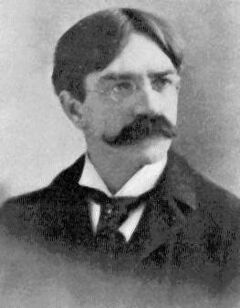
Charles G.D. Roberts, from unknown date and place. Courtesy Library and Archives Canada, C-006718.
"Determining to work free-lance, Roberts separated from his wife, daughter, and sons in 1897, leaving Canada for New York City."[9] During 1897 and 1898 he worked for The Illustrated American as an associate editor.[7]
In New York Roberts wrote in many different genres, but found that "his most successful prose genre was the animal story, in which he drew upon his early experience in the wilds of the Maritimes. He published over a dozen such volumes between Earth's Enigmas (1896) and Eyes of the Wilderness (1933).... Roberts is remembered for creating in the animal story, along with Ernest Thompson Seton, the one native Canadian art form."[3]
Roberts also wrote historical romances and novels. "Barbara Ladd (1902) begins with a girl escaping from an uncongenial aunt in New England in 1769; it sold 80,000 copies in the US alone."[2] He also wrote descriptive text for guide books, such as Picturesque Canada and The Land of Evangeline and Gateways Thither for Nova Scotia's Dominion Atlantic Railway.[13]
Roberts famously became involved in a literary debate known as the nature fakers controversy after John Burroughs denounced his popular animal stories, and those of other writers, in a 1903 article for Atlantic Monthly. The controversy lasted for nearly 6 years and included important American environmental and political figures of the day, including President Theodore Roosevelt.[14]
Europe and return[]
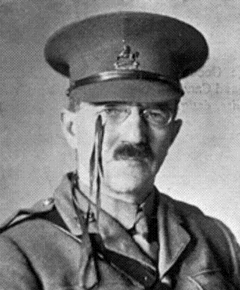
Roberts in World War I. From Canadian Poets, 1916.
In 1907 Roberts moved to Europe.[3] 1st living in Paris, he moved to Munich in 1910, and in 1912 to London, where he lived until 1925.[9] During World War I he enlisted with the British Army as a trooper, eventually becoming a captain and a cadet trainer in England.[7] After the war he joined the Canadian War Records Office in London.
Roberts returned to Canada in 1925 which "led to a renewed production of verse."[3] During the late 1920s he was a member of the Halifax literary and social set, The Song Fishermen.
He married his 2nd wife, Joan Montgomery, on October 28, 1943 at the age of 83, but became ill and died shortly thereafter in Toronto. The funeral was held in Toronto, but his ashes were returned to Fredericton.[6] He is buried in Fredericton's Forest Hill Cemetery.[15]
Writing[]
Early work[]
Roberts's 1st book, Orion, and other poems (1880), was a vanity book for which he had to "pay an advance of $300, most of which he borrowed from George E. Fenety, the Queen's Printer for New Brunswick, soon to become his father-in-law." Orion was "a collection of juvenilia, written while the poet was still a teenager."[8]
Critic Desmond Pacey wrote in 1958 that "when we remind ourselves that it was published when the poet was twenty ... we realize that it is a remarkable performance. It is imitative, naively romantic, defective in diction, the poetry of books rather than life itself, but it is facile, clever, and occasionally distinctly beautiful.... It is the work of an apprentice, who is quite frankly serving under a sequence of masters from whom he hopes to learn his art."[16]
The title of Roberts's next book, In Divers Tones, "aptly describes the hodgepodge of its contents. The selections vary greatly, not only in style and subject matter, but also in quality.... Among those written between 1883 and 1886 ... there is evidence of a maturing talent. In fact, it might be argued that at least three of these poems – 'The Tantramar Revisited,' 'The Sower,' and 'The Potato Harvest – were never surpassed by any of his subsequent verse."[8]
By the time of Songs of the Common Day, and Ave (1893), Roberts "had reached the height of his poetic powers.... It is the sonnet sequence of Songs of the Common Day that has established Roberts' reputation as a landscape poet.... Evidence of the Tantramar setting occurs in lines like 'How sombre slope these acres to the sea' ('The Furrow'), 'These marshes pale and meadows by the sea' ('The Salt Flats'), and 'My fields of Tantramar in summer-time' ('The Pea-Fields'). The descriptions are full of evocative details." [8]
Middle period[]
After Roberts turned to free-lance writing in 1895, "Financial pressure forced him to turn his main attention to fiction." [3] He published 2 more books of poetry by 1898, but managed only 2 more in the following 30 years.
"As their titles often indicate, the numerous seasonal poems in The Book of the Native [1897] were written with an eye on the monthly requirements of the magazines: 'The Brook in February,' 'An April Adoration,' 'July,' and 'An August Woodroad.'" Roberts "is generally at his best in the poems in which he depicts these seasonal stages of nature with the palette of a realistic landscape painter."[8] However, the book also "signalled a shift in his poetic oeuvre away from descriptive, technically tight Romantic verses to more mystical lyrics."[6]
"Most of the nature poetry in Roberts's New York Nocturnes, and other poems [1898] was written before he moved to New York. It belongs to a period of upheaval, desperation and overwork, which may at least partly account for its disappointing slackness.... Even 'The Solitary Woodsman,' much anthologized and frequently praised, is a series of unremarkable images made tedious by 52 lines of irritating rhythm and rhyme.... Roberts seldom looks at New York with the eye of a painter, and never captures its essence with the effectiveness he displays in his best pictures of rural landscape.... Instead of turning an inquiring eye upon urban conditions, he is inclined to retreat from 'the city's fume and stress' and 'clamour' ('The Ideal').".[8]
The opening and title section of The Book of the Rose (1903) was a collection of love poetry. "Roberts handling of the symbol sounds artificial at best and sometimes downright fatuous.... Although most of the poems in the second section are unimpressive, there are a few exceptions. 'Heat in the City,' noteworthy for being the best poem he ever wrote about city life, effectively evokes the distress and despair of the tenement-dwellers.... The final poem in the book, 'The Aim,' is remarkable for its frank self-analysis."[8] The book also includes Roberts's moving Christmas poem, "When Mary the Mother Kissed the Child."
"New Poems, a slim volume published in 1919, shows the drop in both the quantity and quality of Roberts' poetry during his European years. At least half of the pieces had been written before he left America, some as early as 1903." [8]
Later poems[]
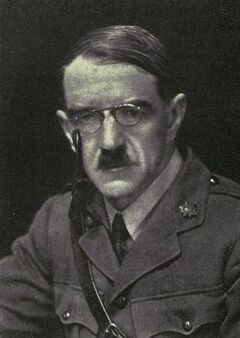
Charles G.D. Roberts in Canadian Singers and their Songs, 1919. Courtesy Internet Archive.
Roberts's "return to Canada in 1925 led to a renewed production of verse with The Vagrant of Time (1927) and The Iceberg, and other poems (1934)."[3] Pacey calls this period "the Indian summer of his poetic career."[8]
"Among the best of the new poems" in The Vagrant of Time "is the one with this inspired opening line: 'Spring breaks in foam along the blackthorn bough.' In another love poem, 'In the Night Watches,' written in 1926, his command of free verse is natural and unstrained, unlike the laboured language and forced rhymes of his earlier love poetry. Its synthesis of lonely wilderness setting with feelings of separation and longing is harmonious and poignant." [8]
"Most critics rank 'The Iceberg' (265 lines), the title poem of the new collection" published in 1934, "as one of Roberts' outstanding achievements. It is almost as ambitious as 'Ave!' in conception; its cold, unemotional images are as apt and precise in their detached way as the warmly-remembered descriptions in 'Tantramar Revisited.' [8]
Animal stories[]
The Canadian Encyclopedia says that "Roberts is remembered for creating in the animal story, along with Ernest Thompson Seton, the one native Canadian art form."[3] A typical Roberts animal story is "The Truce".
In his introduction to The Kindred of the Wild (1902), Roberts called the animal story "a potent emancipator. It frees us for a little from the world of shop-worn utilities, and from the mean tenement of self of which we do well to grow weary. It helps us to return to nature, without requiring that we at the same time return to barbarism. It leads us back to the old kinship of earth, without asking us to relinquish by way of toll any part of the wisdom of the ages, any fine essential of the 'large result of time.' (Kindred 28)" [17]
Critical interest in Roberts's animal stories "emerged in the 1960s and 70s in the growth of what we now know as Canadian Literary Studies.... But these critics tended as a group to see in the animal stories a masked reference to Canadian nationhood: James Polk 'attempts to subsume the animal genre entirely within the identity crisis of an emerging nation [seeing] the sympathetic stance of Seton and Roberts towards the sometimes brutal fate of the 'lives of the hunted' as a larger political allegory for Canadaâ's 'victim' status as an American satellite. (Sandlos 74)'" [17]
Margaret Atwood devotes a chapter of her 1971 critical study Survival: A Thematic Guide to Canadian Literature to animal stories, where she states the same thesis: "the stories are told from the point of view of the animal. That's the key: English animal stories are about the 'social relations,' American ones are about people killing animals; Canadian ones are about animals being killed, as felt emotionally from inside the fur and feathers. (qtd. in Sandlos 74; emphasis in original)." [17]
Recognition[]
Roberts was elected a Fellow of the Royal Society of Canada in 1893.[9]
Roberts was elected to the United States National Institute of Arts and Letters in 1898.
He was awarded an honorary LL.D. from UNB in 1906, and an honorary doctorate from Mount Allison University in 1942.[6]
For his contributions to Canadian literature, Roberts was awarded the Royal Society of Canada's inaugural Lorne Pierce Medal in 1926.[6]
On June 3, 1935, Roberts was 1 of 3 Canadians on King George V's honour list to receive a knighthood (Knight Commander of the Order of St. Michael and St. George).[8]
Roberts was honored by a sculpture erected in 1947 on the UNB campus, portraying him with Bliss Carman and fellow poet Francis Joseph Sherman.[6]
"In the 1980s - a hundred years after his 1st volumes appeared - a major Roberts revival took place, producing monographs, a complete edition of his poems, a new biography, a collection of his letters, etc. A Roberts Symposium at Mount Allison University (1982) and another at the University of Ottawa (1983) included several scholarly reappraisals of his poetry." [8]
Roberts was declared a Person of National Historic Significance in 1945, and a monument to him was erected by the Historic Sites and Monuments Board of Canada in Westcock in 2005.[6]
Publications[]
Poetry[]
- Orion, and other poems. Philadelphia: Lippincott, 1880.
- In Divers Tones. Boston: Lothrop, 1886.
- Ave! An ode for the centenary of the birth of Percy Bysshe Shelly. Toronto: Williamson, 1892.[18]
- Songs of the Common Day / Ave! An Ode for the Shelley Centenary. Toronto: William Briggs, 1893. Montreal: C.W. Coates, 1893. London: Longmans Green, 1893.[18]
- The Book of the Native. Toronto: Copp Clark, 1896; Boston: Lamson, Wolfe, 1896.
- New York Nocturnes, and other poems. Boston: Lamson Wolffe, 1898.
- Poems. New York: Silver, Burdett, 1901.[18]
- The Book of the Rose. Toronto: Copp, Clark, 1903; Boston: L.C. Page, 1903.
- New Poems. London: Constable, 1919.
- The Sweet o' the Year, and other poems. Toronto: Ryerson, 1925.
- The Vagrant of Time. Toronto: Ryerson, 1927.
- The Iceberg, and other poems. Toronto: Ryerson, 1934.
- Selected Poems. Toronto: Ryerson , 1936.
- Selected Poems (edited by Desmond Pacey). Toronto: Ryerson, 1955.[18]
- Collected Poems (edited by Desmond Pacey & Graham Adams). Wolfville, NS: Wombat Press, 1985.[18]
Except where noted, information on poetry courtesy Canadian Poetry.[19]
Novels[]
- The Forge in the Forest. Boston: Lamson, Wolffe, 1896. New York: Grosset & Dunlap, 1896. Toronto: William Briggs, 1897.
- The Raid from Beausejour / How the Carter Boys Lifted the Mortgage (2 novelettes). New York, Cincinnati: Hunt & Eaton, Cranston & Curts, 1894. Toronto: Musson, 1900.
- Reube Dare's Shad Boat: a tale of the tide country. New York, Cincinnati: Hunt & Eaton / Cranston & Curts, 1895. (novelette)
- A Sister to Evangeline. Boston & New York: Silver, Burdett, 1900.
- Barbara Ladd. Boston: L.C. Page, 1902; New York: Grosset & Dunlap, 1902.
- Kings in Exile. London: Ward, Lock, 1908.
- A Balkan Prince. London: Everett, 1913.[20]
Short Fiction[]
- Around the Campfire. Toronto: Musson, 1896. Toronto: William Briggs, 1896. New York: Thomas Y. Crowell, 1896.
- Earth's Enigmas. Boston: Lamson, Wolffe, 1896.
- By the Marshes of Minas. Boston, New York: Silver, Burdett, 1900.
- The Feet of the Furtive. London: Ward, Lock, 1900.
- The Heart of the Ancient Wood. Toronto: Copp Clark, 1900.
- The Haunters of the Silences. London: Thomas Nelson, 1900.
- The Kindred of the Wild Boston: L.C. Page, 1902.
- The Prisoner of Mademoiselle: A love story. Boston: L.C. Page, 1904.
- The Watchers of the Trails. Toronto: Copp Clark, 1904.
- Red Fox. Toronto: Copp Clark, 1905. (short story)
- The Watchers of the Campfire. Boston: L.C. Page, 1906.
- The Heart That Knows. Boston: L.C. Page, 1906; Toronto: Copp, Clark, 1906.
- The Cruise of the Yacht 'Dido'. Boston: L.C. Page, 1906.
- The Little People of the Sycamore. Charles Livingston Bull illus. Boston: L.C. Page, 1906.
- The Return to the Trails. Charles Livingston Bull illus. Boston: L.C. Page, 1906.
- In the Deep of the Snow. Toronto: Musson, 1907. New York: T.Y. Crowell, 1907.
- The Young Acadian. Boston: L.C. Page, 1907.
- The Haunters of the Silences. Boston: L.C. Page, 1907.
- The House in the Water. Boston: L.C. Page, 1908. London: Ward, Lock, 1908.
- The Backwoodsmen. New York: Macmillan, 1909.
- More Kindred of the Wild. London: Ward, Lock, 1911.
- Neighbours Unknown. London: Ward, Lock, 1910. New York: Macmillian, 1911. (short stories)
- Babes of the Wild. Warwick Reynolds illus. London: Cassell, 1912.
- Children of the Wild. Paul Bramson illus. New York: Macmillan, 1913.
- Hoof and Claw. London: Ward, Lock, & Co., 1913. New York: Macmillan, 1914. (short stories)
- The Secret Trails. New York: Macmillan, 1916.
- The Ledge on Bald Face. London: Ward, Lock, & Co., 1918.
- In the Morning of Time. London: Hutchinson, 1919; New York: Frederick A. Stokes, [1919].
- The Secret Trails. New York: Macmillan, 1921. (short stories)
- Wisdom of the Wilderness. London, Toronto: J.M. Dent, 1922. New York: Macmillan, 1923.
- They Who Walk in the Wilds. New York: Macmillan, 1924.
- Jim: The story of a backwoods police dog. New York: Macmillan, 1931.[21]
- Further Animal Stories (1936)
- When Twilight Falls on the Stump Lots (1945)
- The Last Barrier, and other stories (edited by Alec Lucas). Toronto: McClelland & Stewart, 1958.
- The Vagrants of the Barren, and other stories (edited by Martin Ware). Ottawa: Tecumseh, 1992.
Non-fiction[]
- A History of Canada. Toronto: G.N. Morang, 1898.
- The Canadian Guide-Book. New York: D. Appleton, 1898.
- Discoveries and Explorations in the Century. London, Philadelphia: Linscott, 1904.
- Canada in Flanders (1918) - (non-fiction)
Collected editions[]
- Selected Poetry and Critical Prose (edited by W.J. Keith). Toronto: University of Toronto Press, 1974.[18]
Translated[]
- Phillipe Aubert de Gaspe, The Canadians of Old. Toronto: Hart, 1891.[22]
- Phillipe Aubert de Gaspe, Cameron of Lochiel. Boston: L.C. Page, 1905.[23]
Edited[]
- Poems of Wild Life. London: Walter Scott, 1888.
- William Carman Roberts, Theodore Roberts & Elizabeth Roberts Macdonald, Northland Lyrics (selected & arranged with a prologue by Roberts and an epilogue by Bliss Carman). Boston: Small, Maynard, 1899.[24]
- Canada Speaks of Britain, and other poems of the War. Toronto: Ryerson, 1941.
- Flying Colours. Toronto: Ryerson, 1942.[18]
Letters[]
- Collected Letters. Fredericton, NB: Goose Lane Editions, 1989.
Except where noted, bibliographical information courtesy Open Library.[18]

The Skater
See also[]

The Bird's Song, the Sun, and the Wind by Sir Charles George Douglas Roberts

The Young Ravens that Call Upon Him, by Charles G D Roberts
References[]
- Adams, John Coldwell, Sir Charles God Dam: The life of Sir Charles G.D. Roberts, University of Toronto Press, 1986.[18]
- Sir Charles G.D. Roberts Symposium (edited by Glen Clever). Ottawa: University of Ottawa Presss, 1984.[18]
- Proceedings of the Sir Charles G.D. Roberts Symposium, Mount Allison University. (edited by Carrie Macmillan). Sackville, NB: Centre for Canadian Studies, 1984.[18]
- Pomeroy, Elsie, Sir Charles G.D. Roberts: A biography, Ryerson, 1943.[18]
- Scobie, Charles H.H., Roberts Country: Sir Charles G. D Roberts and the Tantramar, Tantramar Heritage Trust, 2008.
Fonds[]
- Sir Charles G.D. Roberts papers. Charles George Douglas Roberts; Linda Dumbleton; Rose Mary Gibson. Kingston, ON: Queen's University Archives
Notes[]
- ↑ "Sir Charles G.D. Roberts (1860-1943)", Canadian Poetry Archive, Library and Archive Canada, CollectionsCanada.gc.ca, Web, May 10, 2011.
- ↑ 2.0 2.1 "Charles G.D. Roberts," Oxford Companion to Edwardian Fiction, Answers.com, Web, Mar. 29, 2011.
- ↑ 3.0 3.1 3.2 3.3 3.4 3.5 3.6 3.7 W.J. Keith, "Roberts, Sir Charles George Douglas," Canadian Encyclopedia (Edmonton: Hurtig, 1988), 1878.
- ↑ Sara Jamieson, "Charles G.D. Roberts (1860-1943), Poets' Pathway, Poets' Pathway Committee, Web, Feb. 13, 2012.
- ↑ Malcolm Ross, Introduction, Poets of the Confederation (Toronto: McLelland & Stewart, 1960), vii. Print.
- ↑ 6.00 6.01 6.02 6.03 6.04 6.05 6.06 6.07 6.08 6.09 6.10 Thomas Hodd, "Charles G.D. Roberts," New Brunswick Literary Encyclopedia, STU.ca, Web, Apr. 16, 2011.
- ↑ 7.0 7.1 7.2 John Garvin, "Charles G.D. Roberts," Canadian Poets (Toronto: McClelland, Goodchild & Stewart, 1916), 47. UPenn.edu, Web, Mar. 29, 2011.
- ↑ 8.00 8.01 8.02 8.03 8.04 8.05 8.06 8.07 8.08 8.09 8.10 8.11 8.12 8.13 8.14 8.15 8.16 8.17 8.18 John Coldwell Adams, "Sir Charles G.D. Roberts," Confederation Voices, Canadian Poetry, UWO, Web, Mar. 2, 2011.
- ↑ 9.0 9.1 9.2 9.3 9.4 "Selected Poetry of Charles G.D. Roberts (1860-1943), Representative Poetry Online, UToronto.ca, Web, Mar. 29, 2011.
- ↑ Hilary Waterhouse, "Lloyd Roberts," New Brunswick Literary Encyclopedia, Web, June 10, 2011.
- ↑ 11.0 11.1 John Coldwell Adams, "The Whirligig of Time," Confederation Voices, Canadian Poetry, UWO, Web, Apr. 2, 2011
- ↑ Roberts is listed as editor from Vol 1:1 (Dec 6, 1883) to Vol 1:12 (Feb 6, 1884)
- ↑ D.M.R. Bentley, "Charles G.D. Roberts and William Wilfred Campbell as Canadian Tour Guides," Canadian Poetry, UWO. Web, Mar. 23, 2011.
- ↑ Carson, Gerald. February 1971. "T.R. and the 'nature fakers'". American Heritage Magazine. Volume 22, Issue 2.
- ↑ "Sir Charles G.D. Roberts" #8072661, FindAGrave.com, Web, June 23, 2011.
- ↑ Ross S. Kilpatrick, Introduction to Roberts, Orion, and other poems, 1999, Canadian Poetry, UWO, Web, Apr. 8, 2011
- ↑ 17.0 17.1 17.2 "Animal stories: Charles G. D. Roberts and Ernest Thompson Seton," English 354: Early Canadian Literature, Web, Mar. 29, 2011.
- ↑ 18.00 18.01 18.02 18.03 18.04 18.05 18.06 18.07 18.08 18.09 18.10 18.11 Search results=Charles G.D. Roberts, Open Library, Web, May 9, 2011.
- ↑ Charles G.D. Roberts, Confederation Poets, Canadian Poetry, UWO, Web, May 9, 2011.
- ↑ A Balkan Prince (microform) (1913), Internet Archive. Web, Nov. 1, 2013.
- ↑ Jim: The story of a backwoods police dog (1931), Internet Archive. Web, Nov. 1, 2013.
- ↑ The Canadians of old (microform): an historical romance (1891), Internet Archive, Web, July 3, 2012.
- ↑ Cameron of Lochiel. Translated by Charles G.D. Roberts. New ed., with a front (1905), Internet Archive, Web, July 3, 2012.
- ↑ Northland Lyrics (1899), Internet Archive, Web, Nov. 25, 2012.
External links[]
- Poems
- Charles G.D. Roberts in Canadian Poets edited by John Garvin - 7 poems (Cambrai and Marne, Wayfarer of Earth, Monition, At the Gates of Spring, All Night the Lone Cicada, Hilltop Song, O Earth Sufficing All Our Needs), and a critique by James Cappon.
- Roberts in A Victorian Anthology, 1837-1895: "Canada," "The Isles," "Burnt Lands," "The Flight of the Geese," "The Night Sky," "The Deserted City," "Autochthon," "Marsyas," "Epitaph for a Sailor Buried Ashore," "The Keepers of the Pass," "The Bird's Song, the Sun, and the Wind," "Afoot," "Domine, Cui Sunt Pleiades Curae"
- 22 poems by Roberts: "A Song for April," "New Year's Eve," "An April Adoration," "Twilight on Sixth Avenue," "Ballade of the Poet's Thought," "The Frosted Pane," "The Brook in February," "July," "An August Wood Road," "Canada," "The Potato Harvest," "The Autumn Thistles," "The Winter Fields ," "Heat in the City," "To Fredericton in May-Time," "The Skater," "When Mary the Mother Kissed the Child," "In September," "The Furrow," "The Sower," "The Waking of Earth," "Spring Breaks in Foam"
- Roberts, Charles G.D. (1860-1943) - 20 Poems (Ave! [An Ode for the Shelley Centenary 1892]; Bat, Bat, Come Under my Hat; Canada; The Cow Pasture; The Departing of Gluskap; An Epitaph for a Husbandman; The Frosted Pane; The Great and Little Weavers; The Herring Weir; The Iceberg; In an Old Barn; Monition; O Earth Sufficing All our Needs; Philander's Song; The Potato Harvest; The Salt Flats; The Skater; The Solitary Woodsman; Tantramar Revisited; Twilight on Sixth Avenue at Ninth Street) at Representative Poetry Online
- Sir Charles George.Douglas Roberts at PoemHunter (37 poems)
- Sir Charles G.D. Roberts at Poetry Nook (348 poems)
- Books
- Charles G.D. Roberts at Canadian Poetry
- Works by Charles G.D. Roberts at Project Gutenberg
- Charles G.D. Roberts at Amazon.com
- About
- Sir Charles G.D. Roberts in the Encyclopædia Britannica
- Sir Charles George Douglas Roberts in the Canadian Encyclopedia
- Charles G.D. Roberts at UNB Libraries
- Charles G.D. Roberts at New Brunswick Literary Encyclopedia
- Sir Charles G.D. Roberts at NNDB
- Sir Charles G.D. Roberts (1860-1943) at Poets' Pathway
- Charles G.D. Roberts: Mystical Poet, Studies in Canadian Literature
- Charles G.D. Roberts at Find a Grave
| This page uses Creative Commons Licensed content from Wikipedia. (view article). (view authors). |
| This page uses content from Wikinfo . The original article was at Wikinfo:Charles G.D. Roberts. The list of authors can be seen in the (view authors). page history. The text of this Wikinfo article is available under the GNU Free Documentation License and the Creative Commons Attribution-Share Alike 3.0 license. |
- This is a signed article by User:George Dance. It may be edited for spelling errors or typos, but not for substantive content except by its author. If you have created a user name and verified your identity, provided you have set forth your credentials on your user page, you can add comments to the bottom of this article as peer review.
|
